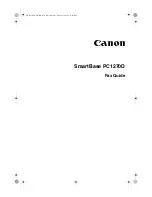
8.6.2. MODEM CIRCUIT OPERATION
The modem (IC5) has all the hardware satisfying the ITU-T standards mentioned previously.
When the ASIC IC1 (61) is brought to a low level, the modem (IC5) is chip-selected and the resistors inside IC are selected by the
select signals from ASIC (IC1) ADR0-ADR4. The commands are written through the data bus, and all the processing is controlled
by the ASIC (IC1) according to ITU-T procedures. The INT signal dispatched from IRQ1, 2 (pins 108 and 121 of IC5) to ASIC (IC1)
when the transmission data is accepted and the received data is demodulated, the ASIC (IC1) implements post processing. This
modem (IC5) has an automatic application equalizer.
With training signal 1 or 2 during G3 reception, it can automatically establish the optimum equalizer. The modem (IC5) operates
using the 32.256 MHz clock (X3).
1. Facsimile Transmission
The digital image data on the data bus is modulated in the modem (IC5), and sent from pin 69 via analog SW (IC10) and
amplifier IC10 and the NCU section to the telephone line.
Refer to CHECK SHEET (P.93)
2. Facsimile Reception
The analog image data which is received from the telephone line passes through the NCU section and enters pin 60 of the
modem (IC5). The signals that enter pin 60 of the modem (IC5) are demodulated in the board to digital image signals, then
placed on the data bus.
In this case, the image signals from the telephone line are transmitted serially. Hence, they are placed on the bus in 8 bit units.
Here, the internal equalizer circuit reduces the image signals to a long-distance receiving level.
This is designed to correct the characteristics of the frequency band centered about 3 kHz and maintain a constant receiving
sensitivity. It can be set in the service mode.
Refer to CHECK SHEET (P.93)
3. DTMF Transmission (Monitor tone)
The DTMF signal generated in the modem (IC5) is output from pin 69, and is then sent to the circuit on the same route as used
for facsimile transmission.
Refer to CHECK SHEET (P.93)
(DTMF Monitor Tone)
Refer to CHECK SHEET (P.93)
4. Busy/Dial Tone Detection
The path is the same as FAX receiving. When it is detected, the carrier detect bit of the register in the modem (IC5) becomes
1, and this status is monitored by the ASIC (IC1).
133
KX-FT901CX-B / KX-FT903CX-B / KX-FT901CX-W / KX-FT903CX-W / KX-FT901CX-S / KX-FT903CX-S
Summary of Contents for KX-FT901CX-B
Page 37: ...37 KX FT901CX B KX FT903CX B KX FT901CX W KX FT903CX W KX FT901CX S KX FT903CX S ...
Page 73: ...73 KX FT901CX B KX FT903CX B KX FT901CX W KX FT903CX W KX FT901CX S KX FT903CX S ...
Page 74: ...74 KX FT901CX B KX FT903CX B KX FT901CX W KX FT903CX W KX FT901CX S KX FT903CX S ...
Page 75: ...75 KX FT901CX B KX FT903CX B KX FT901CX W KX FT903CX W KX FT901CX S KX FT903CX S ...
Page 76: ...76 KX FT901CX B KX FT903CX B KX FT901CX W KX FT903CX W KX FT901CX S KX FT903CX S ...
Page 77: ...77 KX FT901CX B KX FT903CX B KX FT901CX W KX FT903CX W KX FT901CX S KX FT903CX S ...
Page 78: ...78 KX FT901CX B KX FT903CX B KX FT901CX W KX FT903CX W KX FT901CX S KX FT903CX S ...
Page 79: ...79 KX FT901CX B KX FT903CX B KX FT901CX W KX FT903CX W KX FT901CX S KX FT903CX S ...
Page 84: ...84 KX FT901CX B KX FT903CX B KX FT901CX W KX FT903CX W KX FT901CX S KX FT903CX S ...
Page 87: ...87 KX FT901CX B KX FT903CX B KX FT901CX W KX FT903CX W KX FT901CX S KX FT903CX S ...
Page 92: ...92 KX FT901CX B KX FT903CX B KX FT901CX W KX FT903CX W KX FT901CX S KX FT903CX S ...
Page 116: ...116 KX FT901CX B KX FT903CX B KX FT901CX W KX FT903CX W KX FT901CX S KX FT903CX S ...
Page 174: ...16 MEMO 174 KX FT901CX B KX FT903CX B KX FT901CX W KX FT903CX W KX FT901CX S KX FT903CX S ...
















































